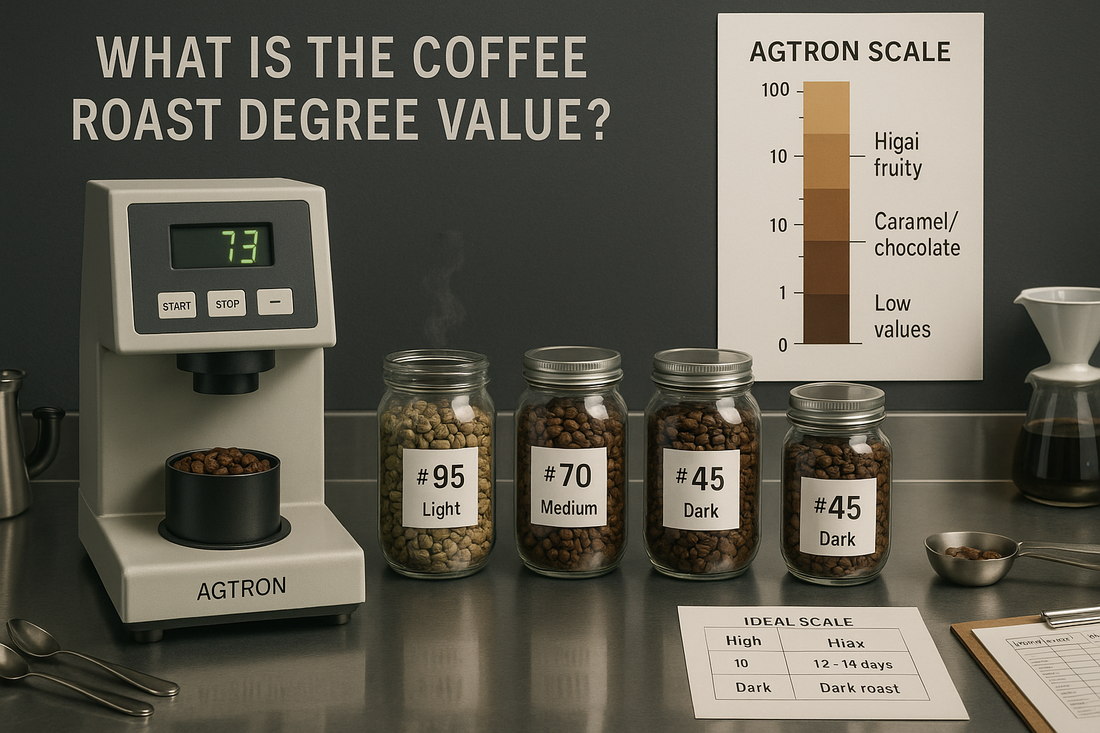
What Is the Coffee Roast Degree Value?
正啟 GLOBALEYESShare this news
The coffee roast degree value is a standardized metric used to quantify the roasting level of coffee beans. It accurately reflects the color changes and internal reactions of the beans during the roasting process. This value is crucial because it not only influences the flavor profile of the coffee but also allows roasters to manage roast depth more scientifically, ensuring consistent quality in every batch. The most common system is the Agtron scale: higher readings indicate a lighter roast, while lower readings indicate a darker roast. By using an Agtron analyzer with near-infrared (NIR) technology to measure the optical characteristics of coffee beans or grounds, roasters can precisely determine roast levels. These data also help baristas quickly adjust extraction parameters to achieve optimal brewing performance for various roast profiles.

Common Roast Degree System: The Agtron Scale
A frequently used roast degree system is the Agtron scale, ranging from 5 to 140. Higher values indicate a lighter roast, while lower values indicate a darker roast. This measurement standard was jointly established by the Specialty Coffee Association (SCA) and the Agtron company in 1996. Agtron instruments use near-infrared (NIR) spectroscopy at specific wavelengths to measure how coffee beans or grounds absorb light, thereby determining roast depth.

It is important to note that the Agtron value does not solely reflect caramelization. Although caramelization during roasting affects bean color, the Agtron scale also accounts for other organic compounds that indicate the degree of roasting. In practice, Agtron values help roasters precisely control roast levels and ensure flavor consistency. Additionally, measurements can be divided into whole bean color readings and ground color readings, with the latter providing a more accurate reflection of the roast level throughout the entire bean.

Using Roast Degree Values to Improve Coffee Quality
Employing roast degree values can effectively enhance coffee quality because it offers a scientific, standardized approach to quantifying and controlling the outcome of coffee roasting. Below are several ways in which these values help improve coffee quality:
-
Ensuring Roast Consistency
Even with the same coffee beans, minor variations in the roasting process can result in different flavor profiles. By using Agtron values to confirm that each batch reaches the same roast level, roasters can maintain a stable flavor. After every roast, coffee professionals measure the Agtron reading and perform cupping to verify consistent quality.

- Precisely Adjusting Flavor
- Light Roast (High Agtron Values): Showcases floral, fruity, and bright acidity, suitable for diverse pour-over coffees.
-
Dark Roast (Low Agtron Values): Highlights caramel, chocolate, and nutty flavors, ideal for those who prefer a heavier mouthfeel.
The roast degree value helps roasters pinpoint each bean’s optimal flavor window and tailor the roast to different consumer preferences.

-
Reducing Human Error
Traditionally, roast levels are judged by the roaster’s experience (visual and olfactory cues), which can be influenced by lighting and subjective perception. Digital measurements provide objective, consistent data that, combined with a roaster’s expertise, minimize the likelihood of errors.

-
Adapting to Different Brewing Methods
Various roast levels demand different extraction parameters. By accurately controlling roast degree values, roasters can adjust their approach for different brewing methods (pour-over, espresso, cold brew) to ensure the best extraction results.

-
Facilitating Extraction Rate Adjustments
Baristas can also use precise roast degree measurements to fine-tune extraction parameters. For example, if you brew an Ethiopian natural coffee at Agtron #85, you’ll get bright acidity and rich fruitiness. If another batch comes out at Agtron #90, using the same parameters might yield a higher perceived acidity. In this case, you could increase the extraction rate to achieve a similar flavor and mouthfeel.


By integrating roast degree values into the roasting process, coffee professionals elevate their craft from an experience-based approach to a data-driven system, achieving greater consistency and efficiency. Numerical analysis not only enables precise flavor adjustments—such as emphasizing floral and fruity notes in light roasts or highlighting robust, full-bodied characteristics in dark roasts—but also allows for the development of optimal roast strategies for different brewing methods (e.g., pour-over, espresso). At the same time, relying on these values reduces human error, helping each batch consistently reach the target roast level. Moreover, these data assist baristas in quickly adjusting extraction parameters for the best possible cup across various roast profiles. In short, roast degree values are not just technical tools for coffee roasting; they are key instruments for enhancing quality and stabilizing flavor.

